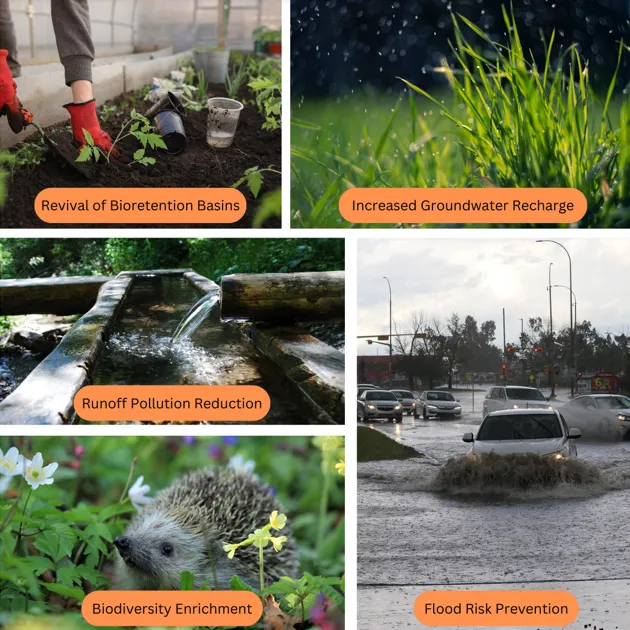
Rain gardens are transformed land depressions designed for storing and infiltrating stormwater runoff flowing from nearby impervious surfaces throughout urban environments. Coming in a variety of shapes and sizes, rain gardens offer a community friendly approach to generating several environmental benefits, such as runoff pollution reduction, increased groundwater recharge, and biodiversity enrichment. Additionally, proper implementation and maintenance of this practice is essential for reversing the ecological damages brought upon by urbanization and exacerbated by climate change. This post will focus on the benefits and design of rain gardens within urban settings, highlighting examples of successful rain garden projects across Southern California and outlining the general guidelines that come with designing one of your own.
Why Rain Gardens?
Definition and Purpose
Rain gardens are shallow landscapes repurposed for collecting rainwater from adjacent roofs, driveways, and streets within urban settings. Considered a best management practice (BMP) for handling stormwater runoff, rain gardens can help reduce runoff pollution, increase groundwater recharge, and provide habitat for native plants and wildlife. Their cost effective and practical nature allows gardeners to mold the space to their community’s liking, allowing gardens to come in variety of different shapes and sizes. These attractive, functional wildlife-friendly spaces are intended to mimic the natural hydrological systems that existed prior to urbanization whilst also enhancing the beauty of our local environments.
How Rain Gardens Improve Water Quality and Reduce Runoff
Rain gardens improve water quality by filtering pollutants like fertilizers, pesticides, animal waste, dirt, chemicals, oil, and bacteria from stormwater runoff. It does so through a practice known as “bioretention” in which collected rainwater is filtered by layers of plants, soil, and sand as it soaks into the ground. This not only minimizes the number of pollutants flowing from our yards into storm drains, and ultimately our watersheds, but also reduces the potential for erosion to occur (Rain Gardens: A Way to Improve Water Quality).
Rain gardens can lessen high volumes of stormwater runoff from large areas of impervious surfaces within Southern Californian urban communities. Compared to the conventional neighborhood lawn, one rain garden allows for approximately 30% more water to infiltrate into the ground and contribute to regional underground aquifer recharge. In addition, unlike ponds, the water that rain gardens capture after a storm event typically drains into the soil within an hour. Further protecting residents from flooding and other sorts of drainage problems (Rain Gardens: A How-To for Homeowners).
Examples of Successful Rain Garden Projects
Rain gardens were always a natural product of our planet’s unaltered ecosystems. However, as urbanization progressed, their overall presence gradually decreased, leading to more water directly running off into local waterways. Maryland stormwater specialists first conceived the modern rain garden in 1990 to mimic the natural filtration properties of natural bioretention basins. The concept has only been growing in popularity ever since. Here are a few examples of successful rain garden projects:
LA StormCatcher: Non-profit environmental organization, TreePeople, debuted the Stormcatcher Cistern Pilot Program. An initiative that aims to unite Los Angeles County/City agencies and community members to develop “smart” rain cisterns and gardens intended for capturing stormwater in response to ongoing drought conditions (LA StormCatcher: You Asked, We Answered).
Crescent Farm: Crescent Farm at the Los Angeles Arboretum features a popular demonstration rain garden for several water saving strategies designed to conserve and infiltrate water, enhance soil health and enrich habitat biodiversity (The Arboretum).
ActiveSGV: Part of the GREEN SGV project funded by the Environmental Protection Agency, this program will install rain gardens in households within high-need communities across the San Gabriel Valley (ActiveSGV to Launch Residential Rain Garden Program).
Guidelines (NOT RULES) for Rain Garden Design and Installation
Find a Good Location
Identify existing drainage patterns within your landscape during a rainstorm event. Locate natural depressions or flat surfaces that will direct water, via gravity, from high points into your rain garden. Downslope areas that naturally receive stormwater runoff from roofs or streets are ideal, but flatter surfaces are easier to dig. Well-drained soils are crucial for rain garden success, so it is recommended to AVOID areas with high water tables or clay soils that do not drain well (Rain Gardens: A How-To for Homeowners).
- AVOID installing in areas that are within 10 feet of your house, often saturated, exhibiting large tree roots, holding ponds, above septic systems, or under heavy shade.
- A location with partial to full sunlight is favorable since it will allow for a wider variety of plants to thrive in your rain garden.
- Before digging, homeowners should call the national “Call Before You Dig” phone number (811) to check and mark for underground utilities. It is a free service that connects residents with their local one-call center to prevent any damage.
Be Creative
No matter if one decides to install a rain garden in their front or back yard, they should choose a size and shape complementary to the yard layout and future landscaping objectives. Some of the most common design shapes are the crescent, kidney, and teardrop. Take pictures and draw a sketch to evaluate your landscape’s slope and assess overall redirection of water. This will help determine which design will be optimal for your bioretention space.
- The slope of your foundation should determine the depth of your garden, but different soil types will have different requirements. A general rule of thumb is that sandy soils have the fastest infiltration rate while clayey soils have the slowest. Therefore, rain gardens in clayey soils will take longer to absorb water and require more surface area than rain gardens in sandy or silty soil.
- Soil feels gritty and coarse = Sandy
- Soil feels smoothy but not sticky = Silty
- Soil feels sticky and clumpy = Clayey
- Rain gardens should generally be large enough to capture 1 inch of rain and are typically between 4 and 8 inches deep. It is important to remember that in any depth, the goal is to keep your rain garden level. For more thorough instructions on how to assess rain garden depth and slope, look at pages 6 through 11 on the Rain Gardens: A How-To for Homeowners handbook.
Catchment & Channel
For good water flow, channels (swales) should exhibit a slope of at least 2% (1/4 inch per foot) towards the rain garden and a depth-to-width ratio no greater than 2:1. The rain garden itself should have a slight slope to the center, with a berm on the downslide slope to prevent erosion.
- DO NOT forget to create an overflow route for further risk reduction of flooding during large storm events. They should be directed towards another suitable area such as a lawn, traditional drainage route, or shrub planting area.
- Utilize gutter systems, downspouts, rain chains, or vegetated swales for efficient water capture. Downspouts are the most effective, however, rain chains typically add more beauty to your home as they hold much potential for styling.
- Rocks, stones, and vegetation can stabilize areas susceptible to soil erosion by providing physical barriers, hindering runoff, and anchoring soil with their root systems.
Plants
Replace any grass with select native plants accustomed to Southern California’s mediterranean climate. When choosing native plants, one should consider the height of each plant, bloom time and color, and its overall texture. The more diverse your selection of plants, the better. This will enhance garden depth and dimension, and the different blooming times will create a longer flowering season. Try incorporating a mix of sedges, rushes, and grasses to maintain normal growth patterns of native plants.
- Plant when soil is dry and amend soil with organic compost to enhance soil health quality and water holding capacity. Randomly clump individual species into groups of 3 to 7 plants. Separate your garden into three main subsections (base, mid-slope, berm) and determine which section your plants belong in.
- Base plants should be able to withstand flooding in winter and aridness in the summer. Consider plants like deer grass [Muhlenbergia patens], Douglas iris [Iris douglasii], prostrate manzanita [Arctostaphylos uva-ursi], buckwheat [Eriogonum species], monkeyflower [Mimulus aurantiacus], and Hummingbird sage [Salvia spathacea] (THE REAL DIRT BLOG: Plant Suggestions for your Rain Garden).
- Mid-slope plants should be small and capable of handling wetter conditions. Consider plants like salt grass [Distichlis spicata], common or spreading rush [Juncus patens], and wood rose [Rosa gymocarpa] (Coastal California Rain Gardens: Capture Rain & Let the Benefits Flow).
- Berms can use small shrubs and trees tolerant of dry summer conditions. SoCal residents are encouraged to also use succulents and other xeriscape plants. Consider Russian sage [Perovskia atriplicifolia], white yarrow [Achillea millefolium], baby's breath [Gypsophila], and sun rose [Mesembryanthemum cordifolium] (Using Rain Gardens To Keep Waterways Pollution-Free).
Maintenance
During storm events, observe whether water is flowing where it’s supposed to and adjust accordingly. Periodically remove any debris, sediment buildup, or weeds as you move forward. The first months should be a very dynamic process for your rain garden. However, after a year and if tended to properly, your bioretention basin should be much more self-sustaining and less grower dependent.
- In your routine mulch applications, use a dense, organic material (shredded wood or coarse wood chips) to inhibit weed growth and retain moisture (Rain Garden - National Centers for Environmental Information).
- AVOID using synthetic fertilizers or herbicides because these chemicals can pollute the water.
- Aerate your soil if the surface becomes clogged with fine sediments. This will help when you water your garden during periods of dry weather.
References
1. “Rain Gardens / RHS.” Rain Gardens / RHS Gardening, www.rhs.org.uk/garden-features/rain-gardens. Accessed 3 Apr. 2025.
2. “Prevent Flooding with Rain Gardens.” Prevent Flooding with Rain Gardens | Jacksonville, NC - Official Website, jacksonvillenc.gov/872/Rain-Gardens. Accessed 8 Apr. 2025.
3. “Soak Up the Rain: Rain Gardens.” EPA, Environmental Protection Agency, www.epa.gov/soakuptherain/soak-rain-rain-gardens. Accessed 8 Apr. 2025.
4. Pokorny, Kim. “Rain Gardens Help Keep Pollutants out of Waterways | Newsroom | Oregon State University.” Newsroom, news.oregonstate.edu/news/rain-gardens-help-keep-pollutants-out-waterways-0. Accessed 8 Apr. 2025.
5. “Rain Gardens: A Way to Improve Water Quality : Landscape.” Center for Agriculture, Food, and the Environment at UMass Amherst, 18 Nov. 2024, www.umass.edu/agriculture-food-environment/landscape/fact-sheets/rain-gardens-way-to-improve-water-quality.
6. Rain Gardens, montgomeryconservation.org/wp-content/uploads/2013/06/Rain-Gardens.pdf. Accessed 8 Apr. 2025.
7. Abdelatif, Erika. “La Stormcatcher: You Asked, We Answered.” TreePeople, 2 Dec. 2015, treepeople.org/2015/12/02/la-stormcatcher-asked-answered/.
8. “Stormcatcher Cistern Pilot Program.” URBAN WATER GROUP, www.urbanwatergroup.com/stormcatcher-cistern-pilot-program. Accessed 8 Apr. 2025.
9. “Crescent Farm - the Arboretumthe Arboretum.” The Arboretum, 8 Sept. 2023, arboretum.org/crescentfarm/.
10. “ActiveSGV to Launch Residential Rain Garden Program.” ACTIVESGV to Launch Residential Rain Garden Program, www.activesgv.org/post/activesgv-to-launch-residential-rain-garden-program. Accessed 8 Apr. 2025.
11. “Rain Gardens: A How-To for Homeowners.” Clean-Water.Uwex.Edu/Pubs/Raingarden, University of Wisconsin–Extension Environmental Resources Center, ddot.dc.gov/sites/default/files/dc/sites/ddoe/publication/attachments/RaingardenHow2HomeownerUWExtension.pdf. Accessed 8 Apr. 2025.
12. “Rain Garden ‘How-to-Video.’” YouTube, The Bay Foundation, 29 May 2015, youtu.be/yG94TuZWUDw?si=VBvIgv2Za5i-oilq.
13. Springer, Alicia. “Plant Suggestions for Your Rain Garden.” UC Agriculture and Natural Resources, The Real Dirt, 31 Mar. 2025, ucanr.edu/blog/real-dirt/article/plant-suggestions-your-rain-garden.
14. Borel, Valerie, et al. “Coastal California Rain Gardens.” University of California Agricultural and Natural Resources, anrcatalog.ucanr.edu/pdf/8531.pdf. Accessed 8 Apr. 2025.
15. Huber, Jeanne. “Using Rain Gardens To Keep Waterways Pollution-Free.” This Old House, 9 Oct. 2024, www.thisoldhouse.com/gardening/21018369/using-rain-gardens-to-keep-waterways-pollution-free#:~:text=Here%20are%20a%20few%20shrubs,Water%20iris%20(Iris%20laevigata).
About the Authors

Daniel Gonzalez II is an associate research and extension specialist at SCREC under the Grizzly Corps Fellowship Program. He focuses on researching and developing nature-based solutions for stormwater management practices in Southern California. Drawing from his background as a certified K-12 educator, Daniel is excited to make watershed and climate-resilient resources more accessible for local communities across Southern California.
Contact at dgonzalezll@berkeley.edu

Dr. Esther N Lofton is an Urban Watershed Resilience Advisor serving Orange, Los Angeles, San Bernardino, and Riverside Counties. She focuses on drinking and environmental water quality, water use efficiency, water supply security, and water equity. Her research is conducted at various scales, such as surface and ground water basins, watersheds, neighborhoods, and field or household scales. Her research is geared towards providing recommendations and guidance to stakeholders such as watershed and stormwater managers, policy makers, and the public to make better decisions on water resources management.
Contact at enmosase@ucanr.edu or (858) 282-6737

Dr. Erik Porse is the Director of the California Institute for Water Resources and an Associate Cooperative Extension Specialist within the University of California Division of Agriculture and Natural Resources (UC ANR). Erik is an engineer, environmental scientist, and policy analyst who focuses on water and environmental management. Since 2011, Erik's work in California has included studies on safe drinking water, efficient urban water use, sustainable groundwater management, water reuse, beneficial uses of stormwater, environmental finance, and water resource systems analysis.
Contact at eporse@ucanr.edu or (530) 240-2612

